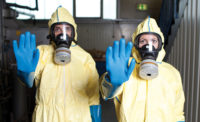As industrial hygienist Dan Markiewicz writes in his “Managing Best Practices” column this month, “You can’t rely on old information. Most of OSHA’s PELs (Permissible Exposure Limits) are based on 1968 TLVs (Threshold Limit Values), with some of the TLVs developed decades earlier. You’re naïve if you only rely on PELs and TLVs for health protection and risk assessment.”
Dan’s far from alone with his warning.
OSHA chief Dr. David Michaels is on record saying: “American workers use tens of thousands of chemicals every day. While many of these chemicals are known or suspected of being harmful, only a small number are regulated in the workplace. New chemicals are being introduced into worksites every year, and we are struggling to keep pace with the potential hazards. As a result, forty years after the creation of OSHA, thousands of American workers are still becoming ill and dying from exposure to hazardous chemicals.
“Updating the PELs has been the number one public policy issue for the association since the mid-1990s and for the first time, we are seeing some real movement from the government sector on this issue,” says American Industrial Hygiene Association President Barbara J. Dawson, CIH, CSP. “AIHA encourages employers, workers and other interested parties to look closely at OSHA’s list of alternate exposure limits because they will bring us closer to updating the PELs.”
PELs are regulations that establish the acceptable amount or concentration of a substance in the air in the workplace. They are intended to protect workers from adverse health effects related to hazardous chemical exposure.
Of the thousands of chemicals used in workplaces, OSHA has PELs for less than 500. Many of the PELs have not been updated since 1971, and current scientific data suggests that, in many instances, the outdated PELs are not sufficiently protective of worker health.
Says OSHA boss Dr. Michaels: “Many of these PELs are dangerously out of date and do not adequately protect workers. Past efforts to update our PELs have largely been unsuccessful. Since 1971, OSHA has successfully established or updated PELs for only about 30 chemicals. We have issued only one new exposure limit since the year 2000. As a
result, many workers are currently being exposed to levels of chemicals that are legal, but not safe.”
In 1989, OSHA attempted to update or set new PELS for more than 350 chemicals in a single rulemaking. Although OSHA presented analyses of the risks associated with these chemicals, as well as the feasibility and economic impacts, the analyses were not as detailed as those for individual rulemakings. The entire rulemaking was ultimately vacated by the court.
Compounding the problem with PELs is that no one knows how many chemicals are in commerce now (the American Chemistry Council estimates there are approximately 8,300 chemicals in commerce in significant amounts) or how many of those chemicals are hazardous. Say OSHA’s Dr. Michaels: “American workers use thousands of chemicals every day, and every year tens of thousands of workers are made sick or die from occupational exposures to hazardous chemicals. While many chemicals are known or suspected to be harmful, only a small proportion are regulated by OSHA.”
Still hanging on to PELS
Still, according to an exclusive ISHN subscriber survey, the overwhelming majority of safety and industrial hygiene personnel use OSHA’s PELs to monitor hazardous substances and as part of their overall employee respiratory protection efforts (85 percent). About one-third (35 percent) of the survey respondents use ACGIH® Threshold Limit Values (TLVs), which are voluntary and updated regularly, and about one-quarter (24 percent) use their own internal company exposure limits – almost always limits more stringent than OSHA’s.
Going beyond mere compliance
OSHA’s Annotated Occupational Exposure Limits table (https://www.osh.gov/dsg/annotated-pels/index/html) provides accurate, up-to-date chemical information to employers who want to voluntarily adopt newer, more protective workplace exposure limits for those chemicals that are covered by outdated OSHA exposure standards. It is one of two web-based resources offered by the agency. The other is a toolkit to assist employers and workers in identifying and substituting safer chemicals to use in place of more hazardous ones.
OSHA will continue to enforce its mandatory PELs. But according to Dr. Michaels these new tables offer a better, more up to date resource on safe exposure limits. The OSHA chief advises employers who want to ensure that their workplaces are safe and their workers are protected to utilize the occupational exposure limits on the annotated tables. He asserts simply complying with OSHA's antiquated PELs will not guarantee that workers will be safe – although, ironically, employers will not be cited if exposures are within PEL ranges.
The annotated tables provide side-by-side comparisons of OSHA PELs with recommended exposure limits of the National Institute for Occupational Safety and Health (NIOSH) and the American Conference of Governmental Industrial Hygienists, as well as the California Division of Occupational Safety and Health's required PELs.
What’s the alternative?
OSHA has called for information on alternatives to the old PELs. Alternative approaches to chemical management include these six examples:
1. Informed substitution to safer chemicals and processes: Uses the most current information on hazardous chemicals to inform employers about safer substances and non-chemical alternatives.
2. Hazard Communication and GHS: Uses the HazCom 2012 classification system as a tool for determining hazard classes and controls.
3. Health hazard banding: Organizes chemicals with similar toxicities into hazard groups, or bands. Hazard banding combined with information on worker exposures may be a useful risk assessment tool when toxicity data are not available.
4. Occupational exposure banding: A method proposed by NIOSH for assessing chemicals; the method sorts chemicals into five bands, with each band representing a different hazard level.
5. Control Banding: Uses hazard statements from labels and safety data sheets as guidelines for establishing chemical controls.
6. Task-based exposure assessment and control: Categorizes job tasks in terms of exposure potential and implements controls to reduce exposures to safe levels.
Don’t delay
OSHA has been working on updating its PELs for more than a quarter century without success. It will still be years before any possible alternative approaches are approved and finalized through formal rulemaking. Meanwhile, many of the country’s largest corporations with industrial hygiene departments and expertise have set their own, stricter in-house exposure limits. According to ISHN’s survey, about one in four companies make use of their own internal limits. One reason to do this is to lower your risk of liability. OSHA’s current PELs will protect you from agency enforcement, but with EU, NIOSH, and many Cal/OSHA exposure limits stricter and publicly accessible, you may be in a legally vulnerable position.







